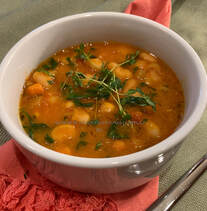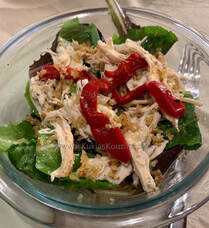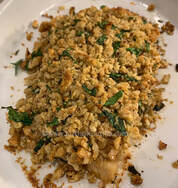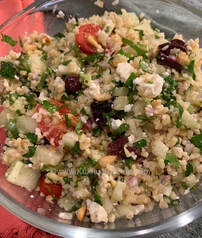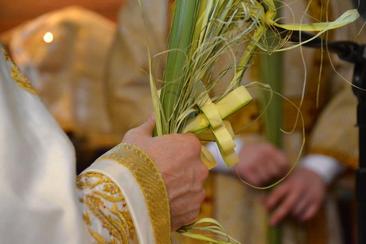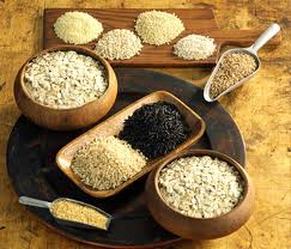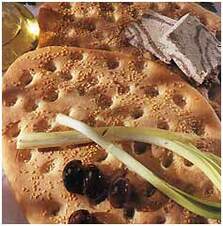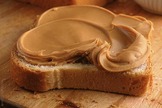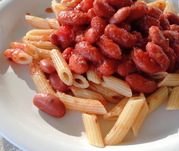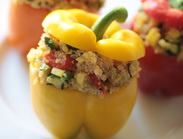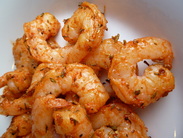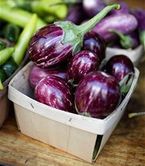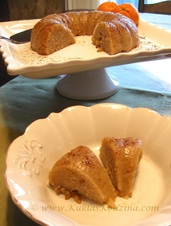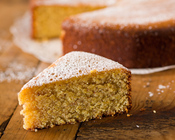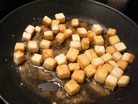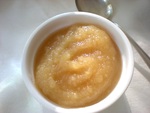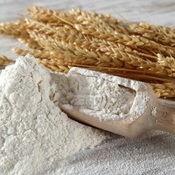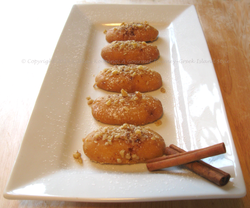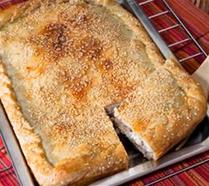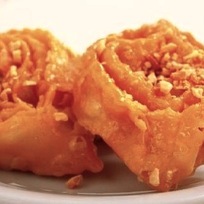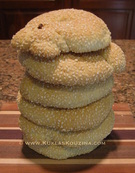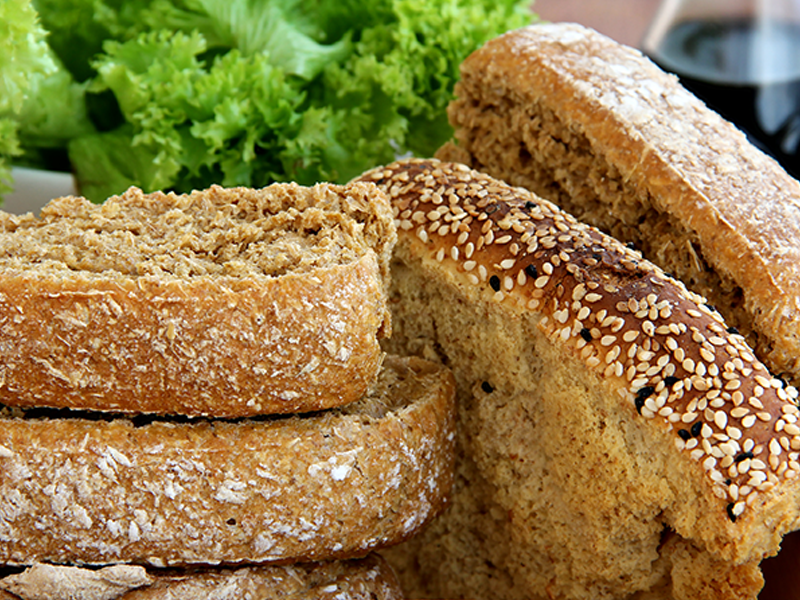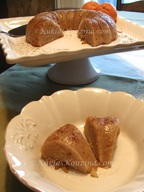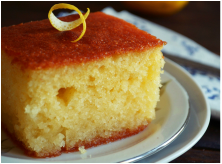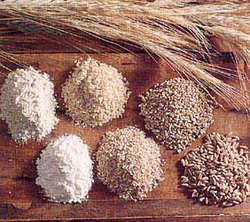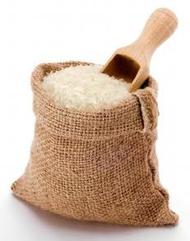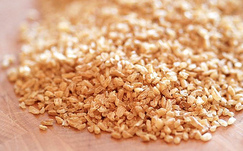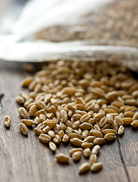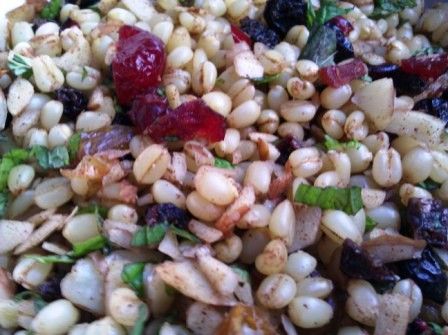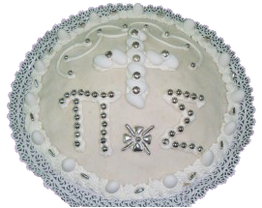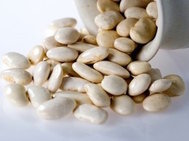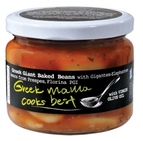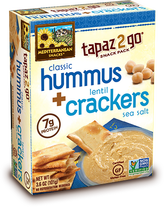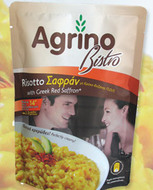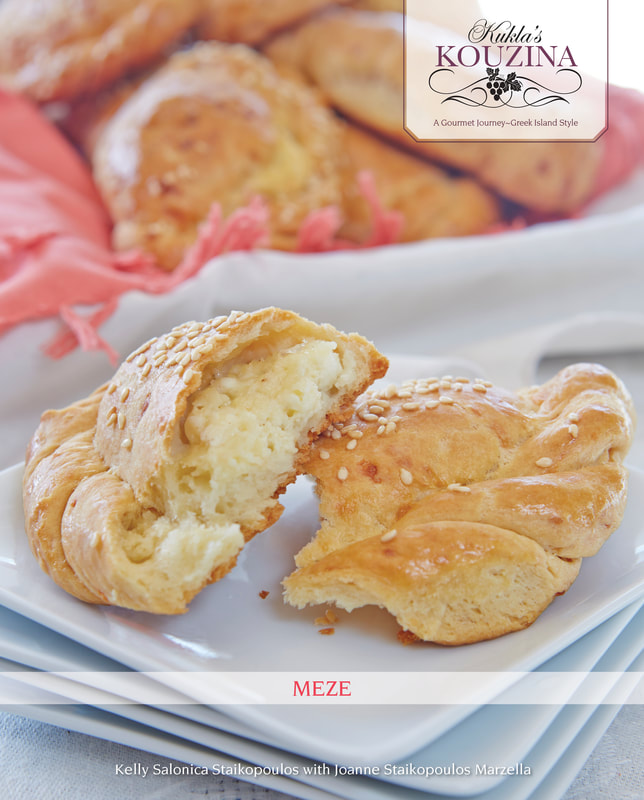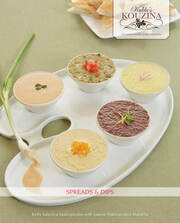The recipes below partner with the corresponding how-to episodes on our new YouTube cooking series, Flippin’ Greek! ™, to show you how we do it in our kouzina. Join us!
GREEK WALNUT-CRUSTED BAKED SALMON (episode S2 E38)
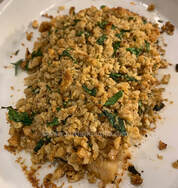
PREP TIME: 15 minutes
COOKING/BAKING TIME: 15 to 20 minutes
SERVINGS: 4
WALNUT TOPPING
2 cups chopped walnuts
1/2 cup plain or whole-wheat breadcrumbs
1/4 cup extra-virgin olive oil
1/4 cup chopped fresh flat-leaf parsley
1/4 cup fresh lemon juice
2 tablespoons minced garlic
Pinch sea salt and freshly ground pepper
*
4 portions (6 ounces each) salmon fillets
1/4 cup extra-virgin olive oil
1/2 teaspoon sea salt
1/4 teaspoon freshly ground pepper
1. Heat oven to 375°F.
2. Make Walnut Topping: In a bowl, stir together the nuts, breadcrumbs, 1/4 cup olive oil, the parsley, lemon juice, garlic, salt, and pepper until combined and the breadcrumbs are moistened.
3. Brush the salmon fillets on all sides with the olive oil and season with the salt and pepper. Transfer to a large baking dish and top the fillets evenly with the walnut topping, lightly pressing down to adhere. Bake about 15 minutes for medium (the fish should flake easily with a fork), about 20 minutes for well done.
BULGUR (POURGOURI) SALAD
TOTAL PREP TIME: 25 minutes plus standing
SERVINGS: 4 to 6
1 cup dried medium-grain bulgur
1/3 cup fresh lemon juice
1/4 cup extra-virgin olive oil
1 seedless cucumber, peeled and diced
1 1/4 cups grape or cherry tomatoes, halved
1 cup finely chopped fresh flat-leaf parsley
3/4 cup crumbled Greek feta, divided (2 tablespoons reserved for topping)
1/2 cup sliced kalamata olives
1/3 cup chopped shallot
1/4 cup toasted pine/pignoli nuts
1 scallion, chopped
2 tablespoons finely chopped fresh mint, plus sprigs for garnish
Sea salt
Freshly ground pepper
1. In a large bowl, cover the bulgur with hot water by 2 inches and let soak 1 hour, until tender and fluffy. Drain in a fine sieve, pressing firmly to expel excess water.
2. In a large bowl, whisk together the lemon juice and olive oil. Toss in the bulgur, cucumber, tomatoes, parsley, feta, olives, shallot, mint, scallion, and nuts. Season with salt and pepper, to taste. Let stand at least 30 minutes before serving for flavors to develop. (Can be made ahead. Cover and refrigerate up to 1 day. Bring to room temperature before serving.) Top with reserved 2 tablespoons feta and serve.
GREEN BEANS WITH SAUTÉED ONION & TOASTED ALMONDS
PREP TIME: 10 minutes
COOKING TIME: about 15 minutes
SERVINGS: 4 to 6
1 1/2 pounds green beans, rinsed and trimmed/string removed
1/4 cup extra-virgin olive oil
1 large onion, sliced (about 2 cups)
2 cloves garlic, thinly sliced
Sea salt
Freshly ground pepper
1/3 cup toasted slivered almonds
1. In a large pot fitted with a steamer basket, bring 1 inch of water to a boil. Place the green beans in the basket, cover, and cook until bright green, about 5 minutes.
2. Meanwhile, in a large skillet, heat the olive oil over medium heat. Add the onion and cook until softened and golden, about 10 minutes. Add the garlic and cook until golden, about 2 minutes more. Add the green beans and almond slivers to the onion mixture, season with salt and pepper, and toss to coat well with oil. Cook until the beans are just fork-tender, about 3 minutes. Transfer to a serving bowl and serve warm.
HERBED-POTATO SKORDALIA
TOTAL PREP TIME 5 minutes, plus more for the roasted potatoes
MAKES 4 servings
8 ounces leftover Classic Greek Lemon-Oregano Roasted Potatoes, at room temperature
1 to 4 cloves garlic (to taste), minced
2 to 3 tablespoons extra-virgin olive oil
2 to 3 tablespoons chicken or vegetable broth
1 tablespoon white-wine or apple cider vinegar
In a food processor, pulse the potatoes until pureed. With processor running, add the garlic, olive oil, broth, and vinegar, processing until creamy and fluffy (adding additional oil and/or broth to reach desired consistency).
Alternative: Make 1 recipe Skordalia (in our Meze and Spreads & Dips cookbooks), substituting 1/3 recipe leftover Classic Greek Lemon-Oregano Roasted Potatoes for the boiled potatoes.
Recipes copyright © Kukla's Kouzina
I hope you enjoy making this special Palm Sunday fish luncheon. Join us next week for our Greek Pascha (Easter) lamb menu—Greek meat that says “Opa”!
Sign up for our e-newsletter (if you haven’t already) and stay connected on social media for cooking tips and recipes, as well as for all Kukla's Kouzina updates and news.
Thanks for following us and we’ll see you here and on YouTube next Monday!
Until then~
Kali orexi! Good appetite!
Kelly
ABOUT Kukla’s Kouzina Flippin’ Greek! ™
Flippin’ Greek! ™ is our new cooking series on YouTube and the next exciting chapter in our kouzina. Every Monday we flip a familiar non-Greek recipe to Greek-island style using ingredients and cooking techniques found in Karpathos. Each episode runs 2 to 15 minutes, the perfect length for us to quickly show you how to recreate foods and beverages/cocktails right alongside us.
The ingredients used in Greek-island cuisine is what sets this style of cooking apart from standard Greek fare, giving meals a fresh take that keeps them interesting. Karpathos, the home of Kukla’s Kouzina, has its own unique style, and we’ll show you how to take common dishes and reinvent them into Karpathian versions with our simple substitutions.
Many think that everyday Greek cooking is made up of dishes like spanakopita (spinach pie), moussaka, and pastitsio. These are classics for sure, but too time-consuming to make on a regular basis. During our time in Karpathos, we learned that the locals’ quick meals made from the island’s staples like fresh vegetables, fruit, herbs, spices, and protein, prepared using certain methods, came out tasting Greek-island delicious. So we thought this would be a great way to bring our hometown flavor into YOUR kouzina, adding some spicy variety to your life while keeping it simple and fast. Recipes for each week will be posted right here on our blog with links to the episodes.
Web design by Kelly Salonica Staikopoulos

